A legacy of resistance
Ukraine's fight for independence during WWII suggests that, even if forced to accept an unjust peace, its people will never surrender the idea of a free land
A memorial wall and a tomb of the unknown soldier honor members of the Ukrainian Insurgent Army in Lychakiv Cemetery in Lviv, Ukraine. (c. Martin Kuz)
Lychakiv Cemetery in the western city of Lviv offers silent testament to centuries of Ukrainian resistance to Russian tyranny. The 400,000 civilians and soldiers buried across its 100 rolling acres include thousands of war dead who perished fighting Moscow, spanning from tsarist times to the Soviet Union to Vladimir Putin’s malign reign. Ukrainians have learned over generations that, as Kremlin leaders change, Russian aggression endures.
A wide, treeless slope called the Field of Mars provides the final resting place for more than 1,000 service members from the Lviv region killed since Russia’s full-scale invasion began three years ago. The toll grows with each sunrise. Cemetery workers excavate new plots every day of the week, preparing the dark earth to receive the lost sons and daughters of Ukraine.
At the base of the hill, near the first row of graves that date to the war’s earliest days, a granite wall memorializes the victims of the country’s last war against Kremlin oppression. Topped with a large golden trident, the nation’s coat of arms, the 15-foot-high wall rises above a tomb of the unknown soldier of the Ukrainian Insurgent Army (Ukrainska Povstanska Armiia).
The UPA, as it was known, served as the military arm of one branch of the Organization of Ukrainian Nationalists (Orhanizatsiia Ukrainskykh Natsionalistiv). Founded in 1929, the OUN split into two groups in 1942, and the more radical offshoot, headed by Stepan Bandera, formed the UPA that year.
Both factions retained the OUN’s root name and guiding ambition to establish an independent Ukrainian state. The desire of people in Ukraine to wrench free of foreign domination — a sentiment most prevalent in the western regions — intensified during the genocidal regime of Soviet dictator Joseph Stalin, who took power in 1924. By the time Germany invaded Ukraine in 1941, he had killed more than 5 million Ukrainians through famine and mass purges, and exiled millions of others to prison camps.
The UPA swelled from an initial force of 20,000 to 25,000 fighters — almost all of them young men from western Ukraine — to an estimated 100,000 to 200,000 within two years. During World War II, the partisans targeted Soviet, German and Polish Communist troops, gaining control of swaths of the country’s west as they parlayed trust among locals and familiarity with the forested, mountainous terrain. The Ukrainians showed a resourcefulness to match their resoluteness, relying entirely on weapons, ammunition and uniforms seized from defeated enemy units to supply their ranks.
Following the Nazi surrender in Berlin in 1945, the UPA attacked Red Army soldiers returning home, and over the next decade, its fighters waged a guerilla war against Moscow in western Ukraine. Insurgent operatives killed 35,000 Soviet military and security personnel and collaborators, along with hundreds of Communist party leaders. The Kremlin retaliated by inflicting heavier losses that depopulated the region and slowly strangled the liberation movement.
The Soviet authorities killed at least 153,000 UPA and OUN personnel and arrested another 134,000, with an unknown number disappeared or dying in prison. More than 500,000 members of the underground and supporters of Ukrainian independence were deported to labor camps, where thousands succumbed to the brutal conditions. One banished to Siberia was Mariya Lazurko. She lies buried in Lychakiv Cemetery in a section reserved for men and women who took part in the resistance and survived or eluded punishment.
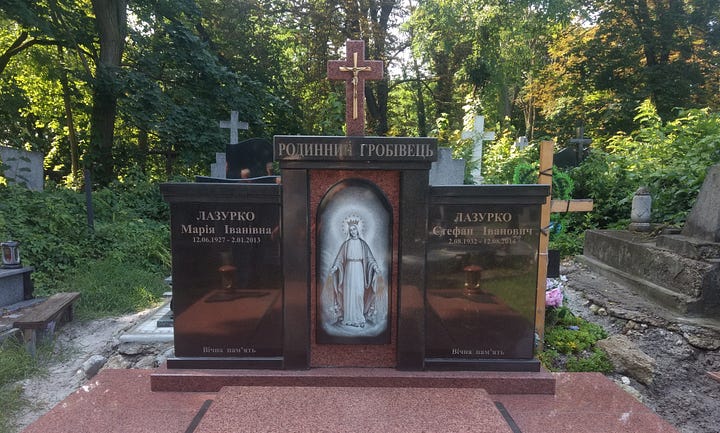
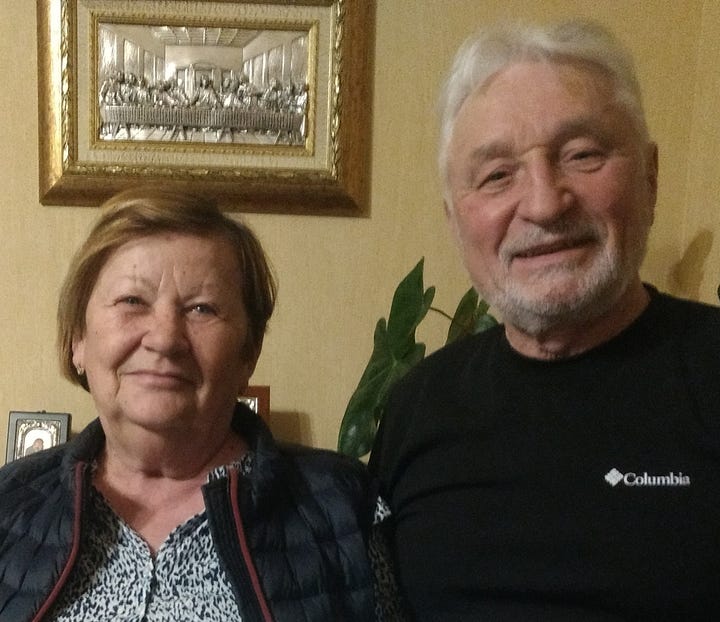
Left: The family grave of Mariya and Stephan Lazurko stands in a section of Lychakiv Cemetery reserved for members of the Ukrainian resistance who survived or eluded punishment from Soviet authorities. Arrested in 1945, Mariya, a courier for the Organization of Ukrainian Nationalists, spent 10 years in a Siberian prison camp. Right: Mariya’s daughter, Iryna Shchuchak, and her husband, Myhajlo, are shown in their home near Lviv. (c. Martin Kuz)
A courier for the OUN in the Lviv region, Mariya delivered messages between group officials, often fulfilling her covert duties under the guise of running errands. Soviet police detained her in 1945 and sentenced her to 10 years of hard labor as an enemy of the state. A year after her release, she gave birth to her daughter, Iryna, and she and her husband, Stephan, chose to conceal her past OUN activities to protect Iryna from potential reprisal.
I learned about Mariya’s past while visiting her grave with Iryna’s husband, Myhajlo Shchuchak. Iryna is my second cousin on my father’s side, and she told me that her mother revealed her OUN history only in 1991, after the Soviet empire collapsed and Ukraine declared independence. (Iryna also found out that her uncle — Mariya’s brother — had belonged to the organization.) I asked why Mariya, who died in 2013, risked her life for the distant dream of a liberated Ukraine.
“Anything to get away from Russia,” Iryna replied. As a young woman in the 1970s, she mounted her own resistance to the Soviet monolith, ignoring pressure from local Communist apparatchiks to join the party. The decision hurt her job prospects and cost her promotions — and reaffirmed that a disdain for Moscow runs in the family DNA. “It is simple,” Iryna said. “We Ukrainians just want to be left alone.”
The Soviet Union’s demise three decades ago allowed the country to begin rescuing its history from Russian distortions and Western generalizations, including the UPA’s bloody, desperate, futile struggle for national sovereignty. The Kremlin regarded the army and Bandera as terrorists for their anti-Soviet crusade. Much of the West condemned the partisans as war criminals owing to elements within the insurgent army participating in massacres of Polish civilians and Ukrainian and Polish Jews in the early 1940s.
The atrocities represent an indelible and indefensible part of the UPA’s legacy. But “part of” remains the crucial phrase for the majority of Ukrainians, who dismiss the criticism of Western scholars that the mass killings nullify any merits of the army’s fight for freedom.
Between 1933 and 1945, “Ukraine was the deadliest place in the world,” Yale historian and author Timothy Snyder has said. Some 13 million to 15 million Ukrainians died in those years, three-fourths of them civilians. In that pitiless context, and without excusing the UPA’s iniquities or Bandera’s embrace of far-right ideology, Ukrainians view the liberation movement through the lens of a people riven by suffering and fearing their own extinction — a fear that Putin’s war revived.
The fierce nationalism that defined the Ukrainian underground, scorned by Russia and the West for different reasons, has evolved into a source of pride as the country again confronts Moscow’s savagery. The UPA’s red and black flag flies outside homes and adorns the graves of fallen soldiers from Lviv in the west to Kharkiv in the east. A slogan that the OUN popularized in the 1930s — Slava Ukraini! (Glory to Ukraine!) — became the official credo of the armed forces in 2018 and has emerged as a ubiquitous national salute since Russia invaded.
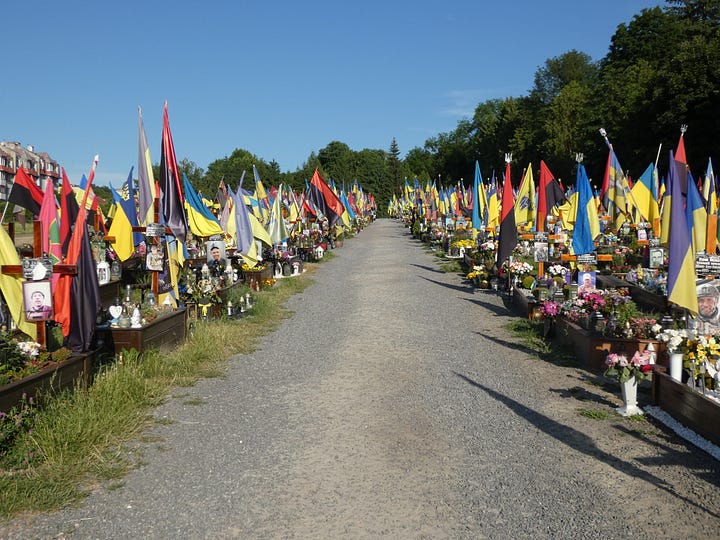
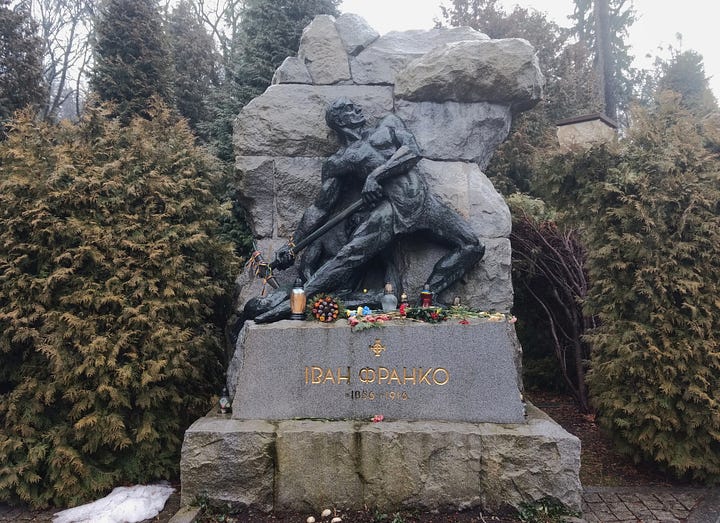
Left: In Lychakiv Cemetery, the red and black flag of the Ukrainian Insurgent Army adorns graves of soldiers killed during Russia’s full-scale invasion. Right: Ukrainian poet Ivan Franko, who lies buried in the 100-acre cemetery, wrote about Ukraine’s desire to break free from the Russian Empire in 1888. (c. Martin Kuz)
The irreducible patriotism of Ukrainians — their love of country in the face of Moscow’s cancerous imperialism — has enabled them to withstand Putin as they once defied Stalin, Lenin and the tsars. The Russian leader and U.S. President Donald Trump appear intent on imposing a ceasefire on Ukraine that hands territory and other concessions to Moscow. But Putin, who poses as a deep thinker on the subject of Russian-Ukrainian relations, might first want to acquaint himself with Ukraine’s resistance 80 years ago.
Ukrainian President Volodymyr Zelensky has asserted that Kyiv will reject a truce that requires the country to demilitarize and accept enforced neutrality. In the event that the Putin-Trump alliance nonetheless produces such an unjust “peace,” I’ll offer a prediction: The accord will ignite a guerrilla war against occupying Russian forces that will make the UPA’s ruthless campaign seem like an Easter egg hunt. (The CIA apparently shares the same view.)
Neither inexhaustible nor delusional, Ukrainians, battered by three years of war, understand the country’s vulnerability. Their yearning to cast off Moscow echoes their forebears, whose fervent wish to escape the Russian Empire moved Ivan Franko to write a poem in 1888 imagining that unburdened future. One of the country’s literary luminaries, and among the prominent historical figures buried in Lychakiv Cemetery, he envisioned a day when his people would shed Russia’s manacles and, at long last, breathe free. The poem ends on a note of determined hope that resonates across the centuries.
The trees of violence and arbitrariness,
And oppression, and tyranny, and darkness
Are not destined to grow in heaven
And block the sun from us forever! It will shine
The bright sun, the clouds will disperse!
Those present strongholds will fall
The prison, and our word will be heard,
Beautiful and fresh, for the whole world, anew!
Etc.
— The Trump administration announced Tuesday that Ukraine and Russia had agreed to a Black Sea ceasefire. Zelensky pledged that Ukraine would adhere to the terms but added, “We have no faith in the Russians.” On cue, the Kremlin insisted on the lifting of certain Western sanctions as a condition of Moscow abiding by the pact. In my last newsletter, I wrote about why Ukrainians possess a deep skepticism of truces with Putin.
— Like Mariya Lazurko, my late father, Eugene Kuz, sought to aid Ukraine in breaking away from the Soviet Union during WWII. I’ve previously written about his life and hard choices for New Lines Magazine, Sactown Magazine and here on Substack.
— My sincere thanks for reading. I hope you’ll offer your comments below if you’re a paid subscriber — I’d like to know what you think. You can also support my self-funded reporting here. And remember to connect with me on Bluesky. Thank you.




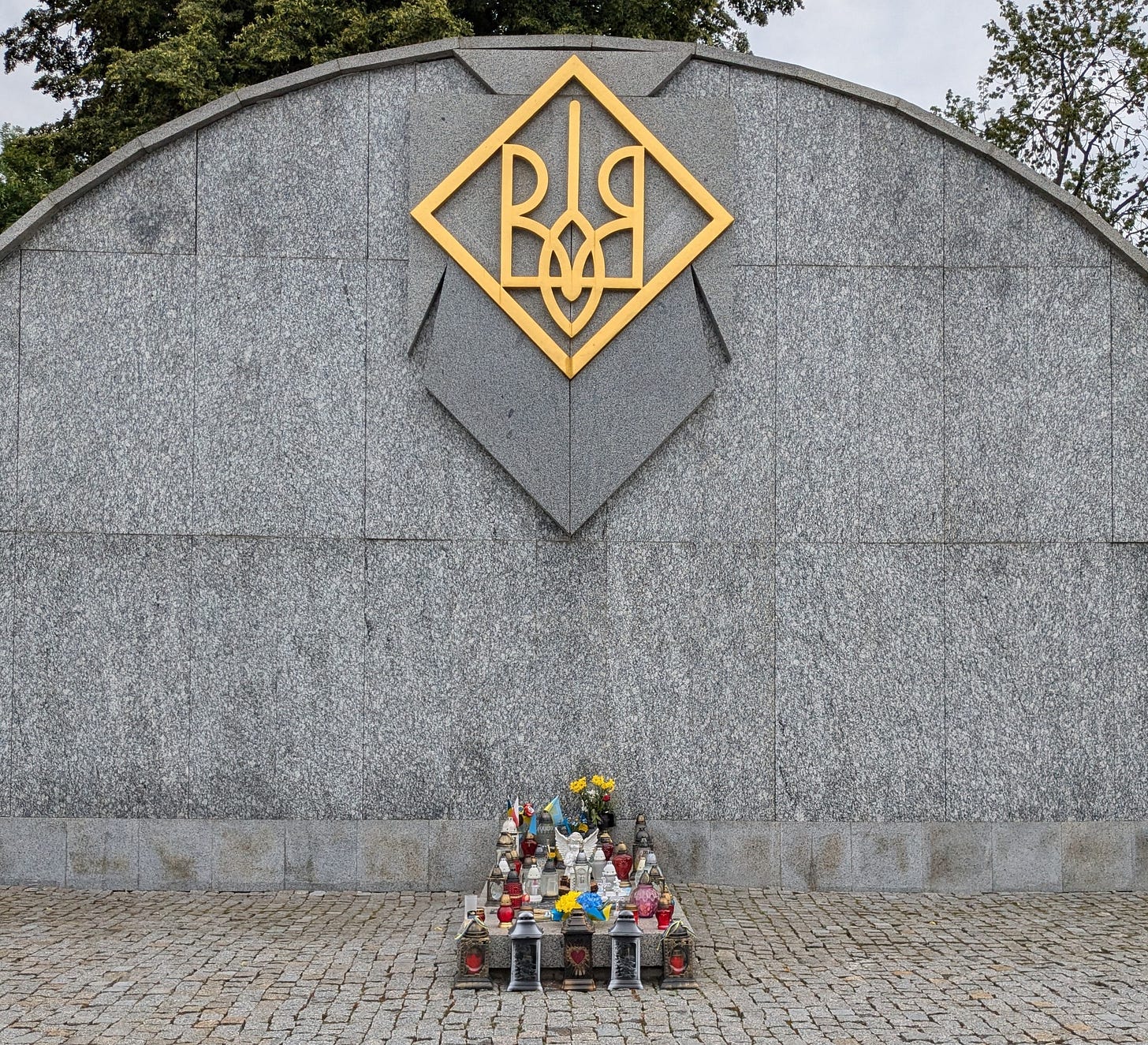
How Americans can be so ignorant of Russia brutalizing Ukraine for decades is not just sad but also shameful. We used to be the protector of the world’s democracies. Now we are too busy dismantling our own to care about anyone else’s.